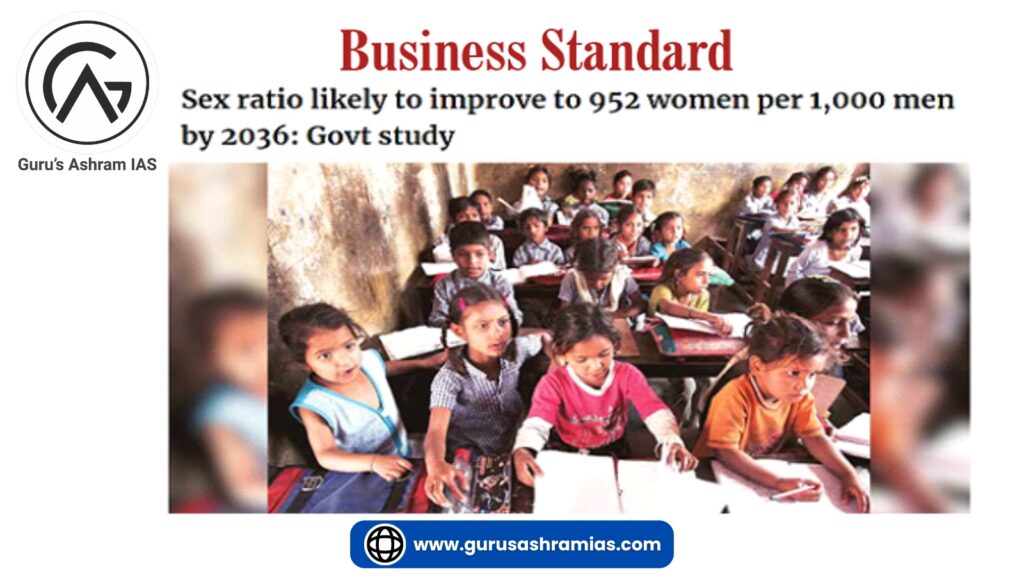Women and Men report in India-2023
- The Ministry of Statistics and Programme Implementation has released the 25th edition of the report titled Women and Men in India-2023.
- It presents a comprehensive overview of gender dynamics in India, including data on population, education, health, economic participation and participation in decision-making.
- It presents disaggregated data by gender, urban-rural divide and geographical area to understand the existing inequalities in the society.
Key features of the 2023 report:
Population:
- India’s population is expected to reach 152.2 crore by the year 2036.
Improving the Sex Ratio:
- The sex ratio in India is expected to increase from 943 in 2011 to 952 females per 1000 males by 2036.
- The female percentage is expected to be 48.8 percent in the year 2036 as compared to 48.5 percent in the year 2011. The number of women in India’s population is expected to be higher in 2036.
The age demographics:
- The proportion of persons under the age of 15 is projected to decline from 2011 to 2036, possibly due to declining fertility.
- Proportion of population aged 60 years and above is projected to increase significantly.
- Age-specific fertility rate (ASFR)
- From 2016 to 2020, the ASFR in the age group 20-24 and 25-29 has declined from 135.4 and 166.0 to 113.6 and 139.6 respectively.
- The ASFR for the age group 35-39 has increased from 32.7 to 35.6 for the above period, indicating that women are thinking of expanding the family once they are settled in their lives.
- ASFR is defined as the number of live births in a specific age group of women per thousand female population of that age group.
- In 2020, the adolescent fertility rate was 33.9 for the illiterate population and 11.0 for the literate.
Maternal Mortality Rate (MMR):
- India has successfully achieved the major milestone of reducing its MMR (97 per lakh live births in 2018-20). (SDG target – reducing MMR to 70 by 2030).
- Maternal Mortality Ratio is defined as the number of maternal deaths during a given time period per 1,00,000 live births during a year.
Infant Mortality Rate (IMR):
- In the year 2020 both male IMR and female IMR were equal at the level of 28 infants per 1000 live births.
- Infant Mortality Rate (IMR) refers to the probability of a child born in a specific year or period dying before reaching one year of age.
Mortality rate of children below five years of age:
- It has declined from 43 in 2015 to 32 in 2020. The gap in the mortality rate of children under 5 years of age between boys and girls has also narrowed.
Labour Force Participation Rate (LFPR):
- Male LFPR has increased from 75.8 to 78.5 during 2017-18 to 2022-23 and Female LFPR has increased from 23.3 to 37 during the same period.
- LFPR is defined as the segment of the working population in the 16-64 age group in the economy that is currently employed or seeking employment.
Participation in the election:
- The participation of women increased to 65.6 per cent in 2014 Lok Sabha elections and to 67.2 per cent in 2019 Lok Sabha elections.
Women Entrepreneurship:
- The Department for Promotion of Industry and Internal Trade (DPIIT) has recognized a total of 1,17,254 start-ups between 2016 and 2023.
- Of these, 55,816 start-ups are run by women, which is 47.6 per cent of the total recognised start-ups.
Exclusive:
- Currently the Indian age pyramids display a triangular shape. According to MoSPI data, by the year 2036, the pyramid will be transformed into a bell shape, thinning towards the top.
- The population pyramid is a graphical representation of the distribution of people according to gender and age group.
The demographic transition model:
- Demographic transition model (population cycle) shows the changes in population growth rate and the impact on population.
- It was developed by American demographer Warren Thompson in the year 1929.
It can be divided into Three stages:
Stage 1:
- The first stage is characterized by high fertility and high mortality as people reproduce more to compensate for deaths due to epidemics and variable food supplies.
- Population growth is slow and most people are engaged in agriculture, where families are large.
- Life expectancy is low, people are mostly uneducated and have low level of technology.
- Two hundred years ago, all the countries of the world were in this phase.
Stage 2:
- Fertility remains high at the beginning of the second stage, but declines over time. Along with this, the death rate has also increased.
- Improving hygiene and health conditions leads to a reduction in mortality. Because of this difference, the net increase in population is higher.
Stage 3:
- Both fertility and mortality decline significantly. The population is either stable or slowly increasing.
- The population becomes urbanized, literate and highly technical and consciously controls the size of the family.
- It shows that man is extremely flexible and is able to adjust his fertility.
- Challenges related to India’s demographic situation:
Prioritizing the child’s:
- India has been facing a skewed sex ratio at birth for many years, which has been a cause of concern.
- Sons are expected to carry forward the family name and help the parents financially, while daughters are seen as a burden due to dowry expenses and leaving the family after marriage.
The ageing population:
- While India has the highest number of young people, old age is still increasing rapidly. The current population of 153 million (aged 60 years and above) elderly is expected to reach 347 million by 2050.
Inequality in health outcomes:
- Among the northeastern states, Assam has the highest infant mortality rate, followed by Meghalaya and Arunachal Pradesh.
- There is still a wide disparity in the health outcomes of children in rural and urban India.
Barriers to women’s LFPR:
- Deep-rooted patriarchal norms and traditional gender roles often limit women’s access to education and employment opportunities.
- Social expectations may prioritize women’s role as caregivers and homemakers, thereby discouraging their active participation in the labour force.
Lack of informed choice in elections:
- There is a lack of education among the public to make informed choices while voting. Voters are also influenced on the basis of their caste and religious identity.
Informal Women Entrepreneurship:
- Women-led enterprises are predominantly rural, small-scale and informal. They mostly work from home which includes textiles, apparel, handicrafts, food processing etc.
- They lack formal financing and social security benefits.
Solution:
Balanced Sex Ratio:
- Periodic meetings should be held with the owners of scan centres to implement the Pre-Conception and Pre-Natal Diagnostic Techniques Act, 1994. Legal action should be ensured against the so-called doctors who perform illegal abortions.
- Use of contraceptives such as oral pills, injections and intrauterine devices may be encouraged to prevent unwanted pregnancies.
Protecting the elderly population:
- India needs to use technology to provide specialized healthcare for senior citizens, promote inter-generational linkages to enrich society, and make healthcare and social services accessible and affordable for the elderly.
This will boost gold prices.
- The Silver Economy includes all economic activities, products and services that are designed to meet the needs of people over the age of 50.
Promoting women’s LFPR:
- Child care subsidies give mothers time to enter the labour force and have a significant impact on female employment.
Supporting women’s entrepreneurship:
- Formalisation of women enterprises, institutional finance and skill development can ensure greater participation and equity for women entrepreneurs.




